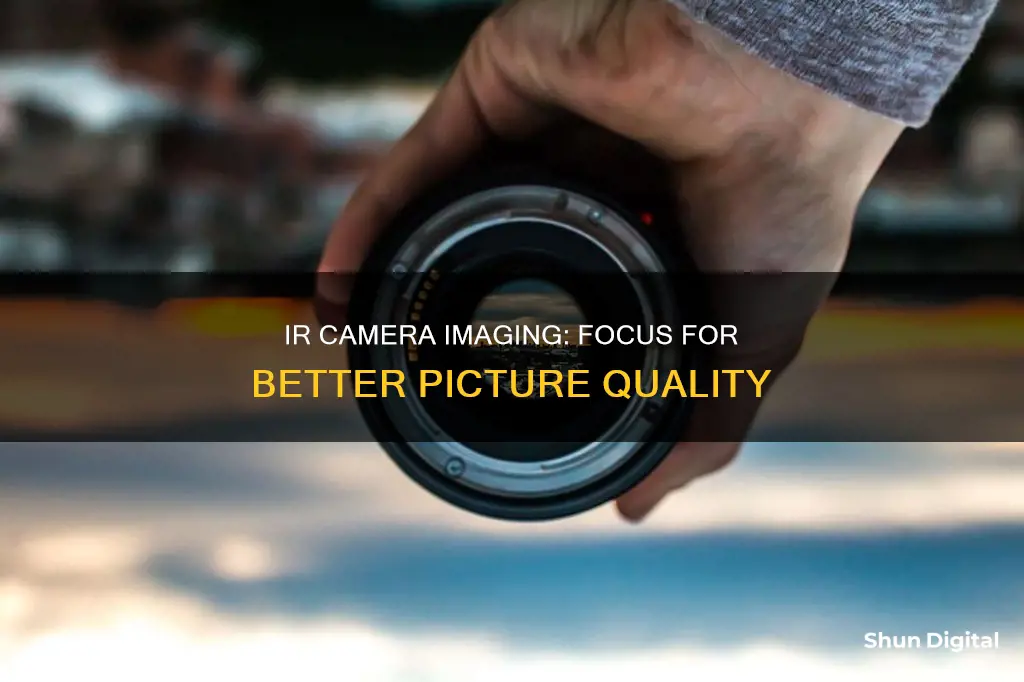
Focusing an IR camera correctly is essential to capturing clear and accurate images. IR light has a longer wavelength than visible light, and regular photographic lenses are designed for the latter, resulting in a shift in focus when capturing IR light. This shift varies depending on the lens and its focal length. Out-of-focus IR images can lead to inaccurate temperature readings and obscure critical anomalies. Therefore, achieving sharp focus is crucial, especially in applications such as industrial inspections, building maintenance, and medical diagnostics, where precise temperature measurements are necessary for decision-making and issue identification.
| Characteristics | Values |
|---|---|
| Importance of focusing IR camera imaging capture | Focusing is the most important setting to improve accuracy in thermal imaging. It is essential to both image quality and temperature accuracy. |
| How IR cameras work | IR cameras detect and convert infrared energy (heat) into an image or signal. IR light is longer in wavelength than visible light and focuses differently. |
| Types of focus | Fixed focus, manual focus, and autofocus. |
| Focus tips | Turn camera to grayscale, look for a sharp edge in the field of view, hold the camera still, use "IR-Fusion" in picture-in-picture mode. |
| Applications of IR cameras | Security, fire detection, wire detection, heat loss measurement, animal health checks, industrial inspections, building maintenance, medical applications, etc. |
What You'll Learn
- Focusing an IR camera is essential to both image quality and temperature accuracy
- IR light focuses differently from visible light, requiring calibration
- Calibration can be to the visible spectrum, a specific lens, or a specific focal length
- Manual focus IR cameras are higher resolution but take longer to focus
- Auto-focus IR cameras are more user-friendly and produce faster results

Focusing an IR camera is essential to both image quality and temperature accuracy
Infrared light focuses differently from visible light, and this shift varies depending on the lens and the location in the zoom range. This makes focusing IR cameras more challenging than traditional photographic lenses. To achieve a sharp image, it is crucial to understand these differences and make the necessary adjustments.
There are several ways to improve the focus of an IR camera. One method is to calibrate the camera to the visible spectrum, allowing the use of existing IR focus marks on lenses to manually correct the focus for each image. Another option is to calibrate the camera to a specific lens, which is a popular choice but has limitations when using zoom lenses. Newer DSLR cameras with Live View and autofocus capabilities offer a convenient solution, providing sharp IR images with various lenses.
The type of focus system selected should match the intended applications. Fixed-focus systems offer point-and-shoot technology suitable for quick scans, while manual focus cameras are often used by experienced thermographers for precise focusing. Auto-focus systems, including laser-assisted autofocus, are also available to expedite the focusing process for users of all skill levels.
By focusing an IR camera properly, users can obtain clear and accurate thermal images, ensuring reliable temperature measurements and effective communication of results to clients or maintenance managers.
Kodak Camera Not Charging: Troubleshooting Guide
You may want to see also

IR light focuses differently from visible light, requiring calibration
Infrared (IR) light has a longer wavelength than visible light. When taking photographs, regular photographic lenses are designed for visible light photography, and therefore IR light will focus differently. This is called an IR focus shift.
DSLR cameras use a phase detect autofocus system, with a second sensor in front of the shutter for focusing. This second sensor focuses on visible light, but the imaging sensor sees IR light. This means that the camera will bring light to focus on the second sensor, but the image captured by the imaging sensor will be out of focus.
IR light is invisible to the human eye, so it is not possible to manually adjust the focus to the correct point. Therefore, IR cameras need to be calibrated to compensate for the IR focus shift. This can be done by calibrating the camera to the visible spectrum, so that the existing IR focus marks on the lenses can be used to manually correct the focus in each image. Alternatively, the camera can be calibrated to a specific lens. However, this may cause issues if a different lens is then used.
Another option is to calibrate the camera to the lens with an average focus shift, which will allow most inaccurate lenses to be brought into focus by adjusting the aperture.
Some newer DSLR cameras have a Live View feature, which allows the imaging sensor itself to focus the image. This means that the image will always be focused properly, regardless of the lens used.
Lollipop Smart Baby Camera: Battery Included?
You may want to see also

Calibration can be to the visible spectrum, a specific lens, or a specific focal length
Calibration is a critical aspect of IR camera imaging capture, ensuring that the camera accurately focuses on the desired object or scene. The process of calibration involves adjusting the camera's settings to compensate for any discrepancies in the autofocus system, which can be caused by various factors such as manufacturing defects, improper shipping handling, or even the nature of the autofocus system itself.
One crucial aspect of calibration is the ability to adjust the camera for a specific spectrum, such as the visible spectrum. This is important because IR light has a longer wavelength than visible light and, therefore, focuses differently. By calibrating the camera to the visible spectrum, photographers can ensure that their images are sharp and clear, with accurate focus on the desired subjects.
Additionally, calibration can be specific to a particular lens. This specificity is essential because different lenses will focus IR light differently. For example, a zoom lens will focus IR light differently at each focal length, and even at different apertures. By calibrating the camera to a specific lens, photographers can minimise focus issues and ensure that their images are consistently sharp, regardless of the lens used.
Furthermore, calibration can also be tailored to a specific focal length. This is advantageous because, as mentioned earlier, the focus can shift at different focal lengths, even within a zoom lens. By calibrating the camera to a particular focal length, photographers can achieve precise focus for their desired field of view, ensuring that the resulting images are crisp and clear.
The process of calibrating an IR camera involves a series of steps, including identifying focus problems, adjusting the camera settings, and verifying the accuracy of the calibration at different distances. This procedure ensures that the camera can consistently capture in-focus images, providing accurate temperature data and reliable results for various applications, such as thermal imaging or photography.
The Anatomy of Camera Apertures: Materials and Functionality
You may want to see also

Manual focus IR cameras are higher resolution but take longer to focus
Focusing is a critical aspect of IR camera imaging capture, as it ensures that the resulting images are sharp and accurate. The process of focusing an IR camera involves calibrating the camera to achieve the proper focus, as IR light has a longer wavelength than visible light and focuses differently.
Manual focus IR cameras offer higher resolution than their autofocus counterparts, producing clearer and more detailed images. This is particularly important in applications such as industrial inspections, building diagnostics, and medical imaging, where accuracy and precision are crucial. However, one of the challenges with manual focus IR cameras is the time required to achieve proper focus.
The focusing process for manual IR cameras involves several steps. First, the lens is focused manually or with autofocus on the desired subject. Next, the focus collar is adjusted to align with the IR mark on the lens, compensating for the IR focus shift. This step ensures that the camera is calibrated to capture IR light accurately. Finally, any necessary filters are attached, and the image is captured.
While manual focus IR cameras offer superior resolution, they may take longer to focus compared to autofocus cameras. This is because manual focusing requires careful adjustment of the lens to compensate for the IR focus shift. In addition, manual focusing may require trial and error to achieve the desired results, especially for beginners or in challenging lighting conditions.
To streamline the focusing process, some manual IR cameras offer features such as focus calibration options and live view functionality. Focus calibration ensures that the camera is optimised for a specific lens, reducing the potential for front or back focus issues. Live view, on the other hand, allows users to see the IR image directly through the lens, making it easier to compose and focus the image accurately.
In conclusion, while manual focus IR cameras offer higher resolution, they may require more time and effort to achieve proper focus. This trade-off between resolution and focusing speed is an important consideration when choosing an IR camera, depending on the specific application and user preferences.
Charging 1080p Camera Batteries: A Step-by-Step Guide
You may want to see also

Auto-focus IR cameras are more user-friendly and produce faster results
Focusing is a critical aspect of IR camera imaging capture, as it ensures accurate temperature readings and clear, sharp images. Auto-focus IR cameras, such as those with the LaserSharp® Auto Focus system, offer distinct advantages in this regard.
User-Friendliness and Convenience
Auto-focus IR cameras eliminate the need for manual focusing, which can be time-consuming and challenging, especially when dealing with multiple objects at different distances. With auto-focus technology, users can simply point, focus, and capture their images within a few seconds. This convenience is further enhanced in mirrorless cameras, which can adjust for IR focus shift in real time, accommodating various lenses without the need for focus calibration.
Accuracy and Reliability
Inaccurate focusing can lead to incorrect temperature readings, potentially impacting decision-making. Auto-focus IR cameras provide consistently accurate temperature data by ensuring that images are always in focus. This is particularly crucial in applications such as preventive maintenance, where detecting abnormal heat patterns can prevent equipment failures and enhance operational efficiency.
Versatility and Adaptability
Auto-focus IR cameras excel in a range of situations, including routine inspections in industrial settings. They can capture accurate images even through obstacles like chain-link fences, ensuring that foreground objects do not hinder the focusing process. Additionally, auto-focus technology adapts to different objects at varying distances, making it a versatile tool for diverse imaging needs.
Speed and Efficiency
The speed at which auto-focus IR cameras capture in-focus images contributes to their overall efficiency. This is essential when time is of the essence, such as in security and surveillance applications where detecting human or animal presence is time-critical. The ability to quickly focus and capture accurate images streamlines the process, making auto-focus IR cameras a valuable tool for time-sensitive tasks.
In summary, auto-focus IR cameras offer enhanced user-friendliness, accuracy, versatility, and speed. By eliminating the challenges of manual focusing, they provide faster and more reliable results, making them a preferred choice for various imaging applications.
Simplisafe Outdoor Camera: Charging Frequency Explained
You may want to see also
Frequently asked questions
Focusing is essential to achieving image quality and temperature accuracy. A blurry thermal image may disguise critical temperature anomalies, leading to incorrect conclusions.
IR cameras focus on infrared energy or thermal energy, which is invisible to the human eye. IR cameras convert this data into an image, assigning a temperature value to each object in the image.
There are three general types of focus systems: fixed focus, manual focus, and auto-focus. Fixed focus cameras are point-and-shoot, while manual focus cameras are used by experienced thermographers and can capture sharper images. Auto-focus systems, such as LaserSharp® Auto Focus, are the most convenient and produce accurate results.
It's important to choose a focus system that matches your specific applications. Consider the level of expertise of the user, the desired image quality, and the time available to achieve focus. For example, manual focus cameras require more time and expertise but can deliver sharper images.
Here are some tips to improve focus:
- Convert the image to grayscale, as it is easier for the human eye to focus on black and white.
- Look for sharp edges in the field of view.
- Keep the camera steady.
- Use "IR-Fusion" in picture-in-picture mode to line up the visible light and IR images, ensuring perfect focus.







